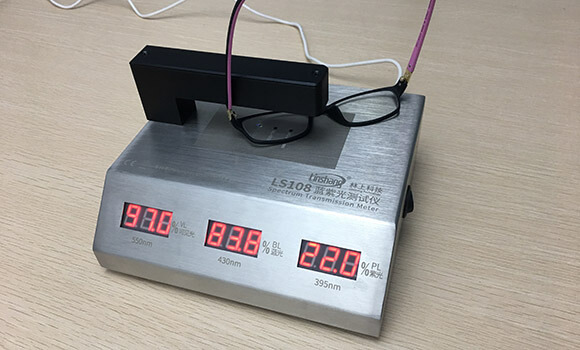Transmittance Meter | Lens Transmittance Standard
Many people take their children to the glasses shop to match glasses, always in a state of layman. I don't understand what is the difference between spectacle lenses of different materials. I even blindly think that the higher the transmittance of spectacle lenses, the better. In fact, the transmittance is only an important factor to judge the quality of the lens. It is often detected by the transmittance meter.
Transmittance generally refers to the ability of the lens to transmit light, which can more accurately reflect its clarity. Generally, the best material for transmission is glass, but its disadvantages are also obvious: the overall weight is large, it is easy to break and the aesthetics is not strong. Therefore, domestic optical shops have gradually eliminated this glass lens.
The common lens materials on the market are as follows: white film (89% transmittance), xie film (transmittance 85%), Kesai film (transmittance 85%), PC (transmittance 85-91%), light white lens (transmission rate 92%), plastic lens (transmission rate 79%), resin sheet (transmission rate 89-92%), coated film (transmission rate 98%). Their light transmittance has great discrepancies. The test results using the transmittance meter are the most accurate. The more common white lens (usually refers to the lens without color), the colored lens with pink gloss is the crocus lens. The former's transmittance can reach 89%, while the latter can reach 85%. Crocker lenses are more capable of absorbing ultraviolet rays and can effectively absorb the stronger light in the air. This lens has good wear and scratch resistance.
Due to the continuous advancement of modern science, resin sheets have gradually become the mainstream of lens production in optical shops. The resin material has a wide range of sources and can be extracted from various plants. Its density is relatively small, the overall quality is light and the transmittance is excellent. The transmittance can be accurately measured between 89-92% by using a transmittance meter. It is worth mentioning that the transmittance of the resin sheet under different light environments is also different.
In the wide visible light area, the transmittance of resin lenses is comparable to that of crystal clear glass. Under ultraviolet light, the resin lens can use 0.4um as a defined value. As the wavelength decreases, its light transmittance also continues to decrease. For some light with a wavelength less than 0.3um, it is almost completely absorbed. In the infrared region, the transmittance of resin lenses will be slightly higher than that of ordinary glass. Therefore, judging the actual transmittance value of the resin sheet needs a professional transmittance meter to help. In general, this kind of resin lens has low cost, strong impact resistance and excellent light transmission, which can meet the different needs of people equipped with glasses.
Transmittance meter is an indispensable instrument in the eyewear manufacturing industry. It has a high degree of refinement, which can effectively help people measure the transmittance of lenses. The data measured by transmittance meter can also intuitively reflect the difference in clarity between different lens materials. Therefore, a high-quality transmittance meter is an important device to ensure that the lens meets the transmittance standard.
Linshang LS108 transmittance meter can not only be used to test the transmittance of visible light, but also accurately detect the transmittance of blue, violet and green light. Its detection standard fully complies with the international standard of CIE photopic luminosity function.
- Features of the LS183 UV Transmittance Meter
- Difference between Visible Light Transmission Meter LS183 and LS108H
- Spectacle lens anti-blue light detection---blue-violet light transmittance meter
- Spectrum Transmission Meter for Measuring PC Sheet
- Difference between LS103A and LS183 spectrum transmission meter
- Measuring the Transmittance of a Hemisphere by Plastic Transmittance Meter
